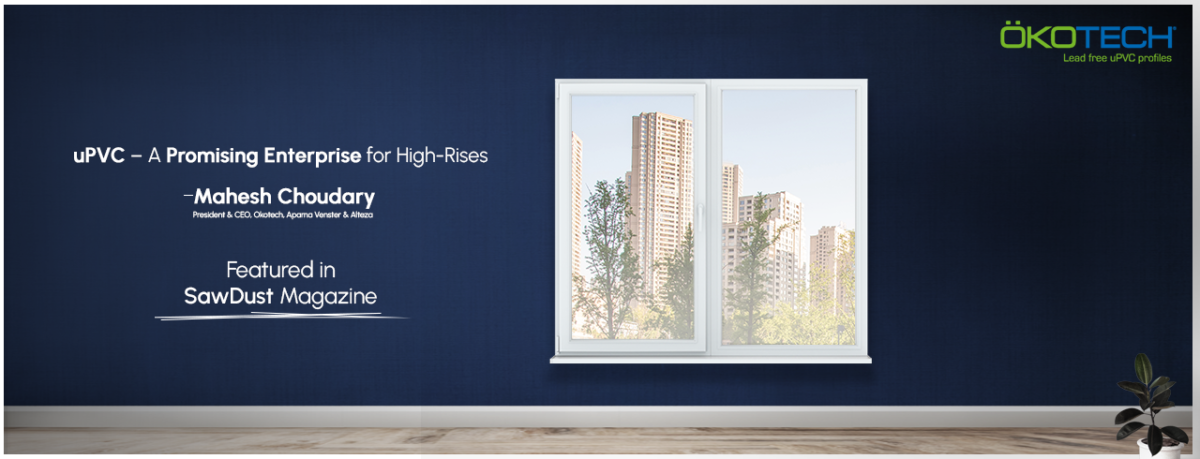“This material has become a favourite choice for a wide range of residential and commercial projects. uPVC windows and doors also offer excellent insulation against rain, superior UV protection, sound insulation, and are also resistant to salt water, termites, fire, and strong winds,” says Mahesh Choudhary, President & CEO, Okotech, Aparna Venster & Alteza
The construction materials sector was among those with the greatest effects during the epidemic. However, the business swiftly found its footing again, and things are much better now. The market size of this particular area is estimated to be approximately USD 225 billion, and it is anticipated to rise by 10% this year. Allied sector segments including ready-mix concrete, uPVC, and tiles are prepared for an optimistic future.
Particularly in recent years, uPVC has shown admirable signs of recovery; it now has a substantial market presence and has regained the majority of its pre-pandemic pace. This enduring image is a result of customers and architects progressively realising the possibilities of uPVC’s strength, durability, simplicity of installation, and affordability of upkeep. This material has gained popularity as a preferred option for a variety of residential and commercial projects. Additionally, uPVC windows and doors provide great rain protection, exceptional UV protection, sound insulation, as well as resistance to fire, high winds, salt water, termites, and fire.
Its wide range of attributes also enables it to find use in a variety of industrial contexts; one such use is the construction of windows and doors for tall structures. Today, high-rise structures are typical sights. In fact, the number of high-rises in a well-known metro area is frequently its defining characteristic. Additionally, this opens up a world of opportunity for the related construction materials sector. Doors, windows, and other structural components for these structures must be strong yet stylish. uPVC windows and doors are useful in this situation.
uPVC windows and doors are ideal for high building structures for a number of reasons, including the following:
- Wind resistance: This is one of its most notable characteristics. uPVC windows and doors can withstand winds that bring large volumes of dust, salt, and other debris, making them ideal for high-rise buildings located both in the middle of a busy metropolis and by the sea. These materials also aid in preventing creaking or whistling noises and make these windows and doors appropriate for high-velocity winds. For increased strength, certain uPVC window companies now provide windows with hurricane bars.
- Safety and security: These are also important in high-rise buildings. Another explanation for why uPVC is quickly gaining favour in the high-rise sector is that it is highly secure and strong. The windows and doors include single and multi-point high-security locking mechanisms connected to the profile’s frame, providing a high level of security. These windows and doors are protected by a thick layer of galvanised steel, making them extremely difficult to break into.
- Customizability: uPVC windows and doors are also extremely customisable. These windows and doors are available in a variety of colour and lamination options and require very little upkeep. This provides them an advantage over traditional materials since they can be customised to fit any theme, which is especially important in the case of high-rise buildings.
- Eco friendly nature: The material’s eco-friendliness and recyclability are the material’s finest features. uPVC has emerged as one such material that fits the bill for these purposes during this time period, when global warming has worsened and companies all over the world are striving to decarbonize and follow the sustainable path. They survive for decades because of their toughness and longevity, and an added plus is that they are created from bio-degradable materials, so they do not hurt the environment in the long run.
- Tactile energy-saving features: One of the material’s far less discussed advantages is its tangible energy-saving capabilities. Today’s escalating energy prices necessitate asset optimization within residential/commercial spaces. Installing uPVC windows and houses would help to tackle this problem to some extent, since they may save up to 30% on family energy expenditures. Because uPVC windows and doors are resistant to extreme temperatures, they help limit heat gain in the summer, keeping home interiors cooler. This allows homeowners who install uPVC windows and doors to automatically reduce their power use.
As the building material industry/real estate sector decarbonizes, builders and homeowners are increasingly turning to uPVC for window and door needs. With uPVC quickly gaining popularity in high-rise development, more builders are trying to include this material in their designs. The demand for uPVC will only grow as areas of application for it become available. If you want a sustainable, yet robust material for your windows and doors, uPVC is your best choice.



